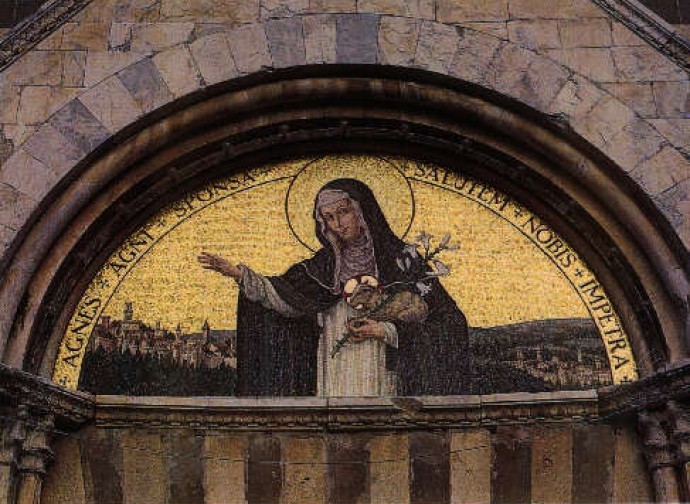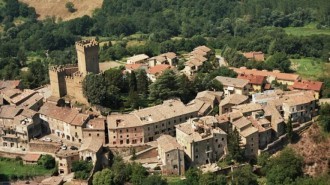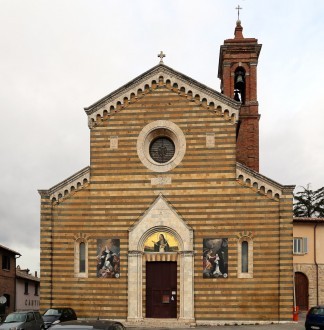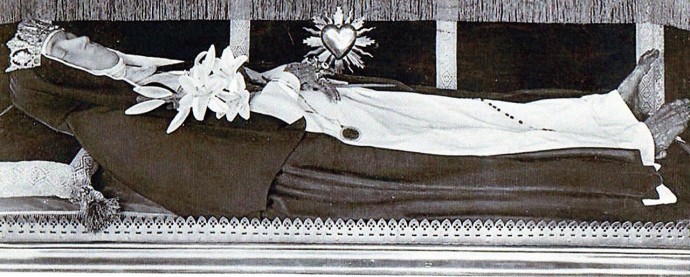Agnes of Montepulciano, an extraordinary life
From an early age Agnese Segni felt the beauty of faith and prayer. She had great mystical and thaumaturgical gifts. At only 15 years of age she became abbess, with a special papal dispensation. She fasted and mortified herself. She united her serious illness with the sufferings of Jesus and, on her deathbed, invited her sisters to rejoice with her.

The young girl busies herself among the long shelves of the monastery pantry. The rough cloth scapular she is wearing gives grace to her movements, despite the simplicity of the fabric. She goes through the supplies and arranges the baskets containing dried vegetables, braids of garlic and onions, bundles of candles tied with string, and jars of olives. She is only fourteen years old, but the Mother Superior trusts her so much that she entrusts the dispensary to her.
She prays in a low voice and the chanting of the prayer sounds like a melody. Suddenly she stops and turns around: she has felt a presence. Blinded by the light she sees, she falls to her knees. And out of the golden halo comes the diaphanous figure of the Virgin Mary. She smiles and speaks to the young woman in a calm voice. She gives her three stones and explains that before she dies she must build a monastery dedicated to her, founding the building on the indivisible Trinity. The Virgin disappears and the young woman remains prostrate for a long time, holding the three stones in her hand. She looks at them and puts them in the alms bag, tied to the long rope around her waist. From that moment on, she lived her life in the light of that apparition.
The young woman was Agnese Segni, born into a wealthy family on January 28, 1268 in Gracciano, a small village near Montepulciano. Mysterious things had been happening around her since she was born, such as a multitude of lighted candles appearing when her mother Francesca gave birth to her. Agnes had felt the allure of faith and the beauty of prayer from an early age. She became ecstatic in front of icons and asked her mother to teach her the prayers. At the age of nine she visited the monastery of Montepulciano and the ‘Sisters of the Sackcloth’, so called because of the coarse material of which their religious habits were made. Back home, Agnes told her parents that she wanted to join them. They did not oppose her; the girl already had a well-defined character that intimidated. They let her go and from that early age she found her place in the world.
The Superior, Sister Margaret, loved her immediately, admiring the little girl’s devotion. After the necessary period of religious instruction, the Superior entrusted the dispensary to her. And it was in this place, which she looked after and kept in order, overseeing the monastery’s supplies, that the encounter with the Virgin occurred, which was to dictate the events of her life. But that was not all. Sister Margaret had noticed the young woman’s power to heal. More than once, sick people who came to the monastery were cured after only a sign of the cross made on their bodies by Sister Agnes. Sister Margaret understood that this young woman was special, that the Lord had plans for her. Therefore she respected and protected her.
 On hearing of the wonders that God worked through Agnes, the administrators of the Castle of Proceno, a nearby town (in the present province of Viterbo), asked the sisters to found a monastery in 1283. The task was entrusted to Sister Margaret, but she accepted on condition that Agnes be her companion. Before entering the village, the two nuns stopped to rest by a felled tree trunk. As the water in the flask had run out, Agnes started digging in the earth with her hands and from the clay clods a spring of fresh water began to flow. That place would later be called Acquasanta [‘Holy Water’]. And so the young nun came to Proceno, together with her Superior, Sister Margaret, to found the monastery in the highest part of the village (today called ‘Poggio di S. Agnese’ – St Agnes’ Hillock). The people of Proceno were so enthusiastic about Sister Agnes’ extraordinary virtues that they asked for her to be elected Prioress of their monastery. This was unheard of, as she was only fifteen years old: a dispensation was granted by Pope Martin IV (1210-1285), who at that time was living in nearby Orvieto.
On hearing of the wonders that God worked through Agnes, the administrators of the Castle of Proceno, a nearby town (in the present province of Viterbo), asked the sisters to found a monastery in 1283. The task was entrusted to Sister Margaret, but she accepted on condition that Agnes be her companion. Before entering the village, the two nuns stopped to rest by a felled tree trunk. As the water in the flask had run out, Agnes started digging in the earth with her hands and from the clay clods a spring of fresh water began to flow. That place would later be called Acquasanta [‘Holy Water’]. And so the young nun came to Proceno, together with her Superior, Sister Margaret, to found the monastery in the highest part of the village (today called ‘Poggio di S. Agnese’ – St Agnes’ Hillock). The people of Proceno were so enthusiastic about Sister Agnes’ extraordinary virtues that they asked for her to be elected Prioress of their monastery. This was unheard of, as she was only fifteen years old: a dispensation was granted by Pope Martin IV (1210-1285), who at that time was living in nearby Orvieto.
The monastery grew rapidly and Agnes was a great example to the nuns and young women who gathered around her. She practised extraordinary self-mortification and it was inexplicable how she could live only on bread and water; on feast days she ate pasta seasoned with breadcrumbs (see the recipe accompanying this article). She slept on the ground, with a stone under her head. In Proceno, Agnes several times performed the wonderful gift of miracles entrusted to her by the Lord: it was enough for her to approach the obsessed and they were freed. On several occasions she multiplied loaves, and the seriously ill regained their health.
She stayed in Proceno for 22 years. During that time, although she was able to dispense healing to others, she was suffering and ill. In the spring of 1306 she was called back to Montepulciano, where she began the construction of a church, as the Virgin Mary had asked her to do in the vision she had had a few years earlier. And so she founded the Monastery of Santa Maria Novella (of which she would be abbess), which would be nourished by Dominican spirituality. (This explains the iconography that depicts Agnes always wearing the white habit and black cloak).
In addition to her qualities as a healer, Agnes proved to be an extraordinary peacemaker. She intervened on numerous occasions in the city to resolve disputes between noble families. Unfortunately, the serious illness she contracted as a result of the severe mortifications, repeated fasting, and austerity she imposed on herself did not let up and her condition worsened. She was bedridden, her strength waning daily. In 1316, Agnes, at the suggestion of her doctor and at the insistence of her sisters, went to Chianciano to be cured at the thermal springs. In the place where she immersed herself a new spring of water flowed out, it was hot and sulphurous. That spring took the name of Bagni di S. Agnese [St Agnes’ Baths]. Her presence helped the many sick people in the area and Agnes worked numerous miracles, but the spa treatment did not help her illness, which worsened.
 On her deathbed, Agnes encouraged her sisters and invited them to rejoice because for her the long-awaited moment of meeting God had arrived. And this happened on April 20, 1317. Since the sisters and the Dominican friars wanted to embalm Agnes’ body, they ordered balsam from Genoa, but there was no need, because a fragrant liquid oozed from Agnes’ hands and feet and impregnated the cloths covering her body. Several ampoules were collected. The echo of the miracle attracted many sick people who wanted to be anointed with the miraculous oil. Her body was not buried, but placed in a wooden urn fitted with a lock that allowed it to be opened and the mortal remains, which remained incorrupt for a long time, to be shown to the faithful.
On her deathbed, Agnes encouraged her sisters and invited them to rejoice because for her the long-awaited moment of meeting God had arrived. And this happened on April 20, 1317. Since the sisters and the Dominican friars wanted to embalm Agnes’ body, they ordered balsam from Genoa, but there was no need, because a fragrant liquid oozed from Agnes’ hands and feet and impregnated the cloths covering her body. Several ampoules were collected. The echo of the miracle attracted many sick people who wanted to be anointed with the miraculous oil. Her body was not buried, but placed in a wooden urn fitted with a lock that allowed it to be opened and the mortal remains, which remained incorrupt for a long time, to be shown to the faithful.
As Blessed Raimondo da Capua wrote in his Legenda in 1366, her body was still intact, as if Agnes had just died, and many miracles of healing took place in the church, which was now known as the Church of St Agnes. Another authoritative source, the Vita [Life] (1606) by Father Lorenzo Sordini Mariani testifies to this. The healings were miraculous and instantaneous and no doctor was able to explain them. There is also a public record of these miracles made by notaries a few months after the saint’s death. According to tradition, she performed other miracles after her death, including having Montepulciano spared from the cholera epidemic of 1855.
The origin of her illness has never been ascertained. The cult of Saint Agnes spread rapidly thanks also to the work of the Dominicans. She was canonised by Benedict XIII (1649-1730) on May 12, 1726 in the Roman church of Santa Maria sopra Minerva. St Agnes’ example of faith and life is a source of inspiration. Even if physical mortifications are difficult for our contemporaries to put into practice, we can at least live without waste, in an austere and simple way: qualities that refine our spiritual life.



